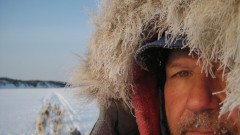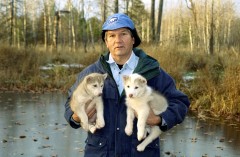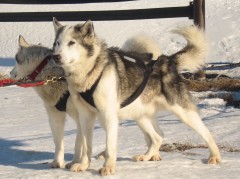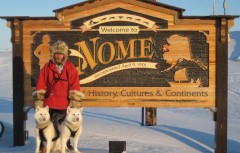It was late at night and he was weak. The last of his hot drink and snacks had been devoured by noon. The rest of his food was stowed deep inside his sled bag. Retrieving it was not an option. His mind was on the safety cabin ahead and the directions locals had offered him to find it, “it’s on the left. If you cross the iron bridge, you went too far.” In the dark of the night, another dog team approached silently from behind. He was unaware of the team’s presence until the lead dogs gently brushed the back of his legs. He was startled. It was the first dog team and musher he’d seen on the trail. Following trail etiquette, he asked which side the overtaking musher preferred to pass on. As the team moved slowly on by the two men made eye contact and he asked, “What’s your name?” The overtaking musher softly replied, “John.” Just as quietly and politely, he replied, “My name is Jim Ryder.” Completing the pass, John looked back and said, “There are about fifteen mushers coming.” Yes, it was John Baker of Kotzebue who passed Ryder and his ten dogs on the portage trail between Kaltag and Unalakleet. In a few days John would claim the 2011 Iditarod Championship in Nome.
Ryder, born and raised in northern Wisconsin was invited by Norman Vaughn, a man he admired as an adventurer, to come do the Serum Run. Jim had the dogs, he had the experience and he was capable of traveling by dog team in the severe north. Time passed and finally he applied for a spot in the run that commemorates the lifesaving delivery of serum to the children of Nome back in 1925. He trained, prepared and registered then drove from Wisconsin to Nenana, the starting point of the Serum Run. He was listed as first alternate but no one dropped out of the lineup. Ryder didn’t get a spot. He was there with a strong dog team. Norman Vaughn had since passed away but for Jim, taking his dog team from Nenana to Nome was a dream he intended to realize. Ryder says the decision to go solo was easy. Traveling alone is something he had experience with. With ten dogs and a sled weighing up to 1,000 pounds, Ryder had previously traveled 750 miles from village to village along the frozen shore of Canada’s Hudson Bay.
Retracing the route of the 1925 Serum Run independently would mean Jim wouldn’t have any of the usual support – food drops, veterinary care, established checkpoints, trail communications, ION Earth tracker, trail breakers and trail sweeps that mushers running the Iditarod or the Serum Run depend on. He wouldn’t even have the roadhouses the Serum Runners of 1925 relied on. He’d be on his own and have to fend for himself and his team. Prior to leaving Nenana, he created his own food drops, calculating 20 pounds of dog food for each day on the trail, packaging it, addressing it to him self and sending it ahead to six villages via the US Postal Service – a very common practice for travelers in bush Alaska. On February 15, 2011 one man and his ten dogs quietly left Nenana at 5:30 in the morning. His plan – arrive in Nome with all his dogs. His rule – survive.
Back in 1925 when diphtheria threatened the children of Nome, anti-toxin was sent by train to Nenana, the closest railhead to Nome. With the medicine still nearly 700 miles from the sick children, time was critical. There was serious controversy as to the best method for transporting the serum. Aviation crusaders said they could get it there fast. Tried and true sled dog drivers said they could get it there for sure. Governor Bone, Alaska’s leader at the time, carefully considered both options. Send it by the experienced mail carriers and their dog teams – the serum would get there but would it get there in time, could the drivers and dogs withstand the extreme weather? Roll one of the few open cockpit planes out of a hanger in Fairbanks, would the plane start, would it function in the severe weather, could the pilot survive the cold, was there sufficient daylight to cover the distance, what about fuel? What if the plane went down? The pilot and serum would be lost – no help for the children of Nome. Much to the dismay of aviation enthusiasts, Governor Bone decided to transport the serum by dog team. A plan was created to organize a relay – 20 drivers and their dog teams would carry the serum the distance. They survived frigid conditions and severe storms to deliver the anti-toxin with amazing speed – 674 miles in just five days and seven hours. For more details read The Cruelest Miles by Salisbury.
Ryder runs Greenland Inuit Huskies – dogs known for their work ethic, strength and hardiness. They don’t wear booties or sport dogs coats and they don’t eat from bowls. They eat snow and eat their kibble and meat right off the snow. Dogs on Ryders team ranged in age from five to fourteen years. Consider the total weight of their load. Empty, the sled weighed 150 pounds. Dog food added 120 pounds or more. Gear including tent, sleeping bag, gun, snowshoes, Jim’s food, safety equipment, extra lines, ropes and more, weighed a little over 100 pounds. Jim, fully dressed in cold gear, started the trip weighing 200 pounds. Add that all together and the weight of the loaded sled was over 500 pounds on a daily basis. With the addition of more dog food, the load on some days would be closer to 800 pounds. When Jim was preparing to depart White Mountain he had his dogs tied off to a pretty hefty snowmachine. The remarkably strong huskies were quite anxious to be on their way. It was as if they thought, hey let us loose from this snowmachine or we’ll take it with us – and that’s exactly what they did – took off and drug the snowmachine down the trail!
On the day that he and his dogs began their journey to Nome, it was forty-three degrees below zero. Severe cold made the start of Ryder’s trip a synonym of when Bill Shannon left Nenana in 1925. In the bitter cold, the trail was fast and hard. When it snowed, the temperature warmed but it made the trail soft and slow. There were times when Ryder had to tie his dogs off, put on his snowshoes, break trail, return to the dogs, move the team forward and repeat the process – not once but time and time again. At the end of the day, he might be only three or four miles closer to Nome. The trail was tough in other ways too. Some sections were known for tussocks similar to what skiers call moguls that made for brutally rough sledding. Step off the trail and Ryder would be wallowing in deep snow. If his sled tipped, and it did on more than one occasion, he’d have to unload it, right it and re-load – not an easy task – especially in deep snow. He was extremely glad to share the trail with snowmachiners. The machines had the effect of packing and grooming the trail.
In one instance a snowmachiner passing by stopped to chat. It had been a tough section of trail for Ryder and his dogs – deep snow, s-l-o-w g-o-i-n-g! He told the driver that he was running low on food. The driver promised to return with food if he hadn’t made the next village in two days. Ryder didn’t reach the village and true to his promise, the machiner returned with food for the musher and his dogs.
Between villages, Ryder camped either in safety cabins or on the trail – yes, literally on the trail. To avoid being swallowed up in deep snow; he’d park his sled, line his dogs out and pitch his tent on the trail. Like a motorist stranded on a highway he’d mark his campsite with reflective markers so as to be seen by approaching snowmachiners.
Upon making a village, Jim was always taken care of by the villagers. People living an Alaska’s bush are second to none when it comes to generosity, friendliness and being helpful. Villagers often offered Jim a place to stay and he enjoyed meals and conversation with locals. In Tanana, Josephine Roberts, the daughter of Edgar Nollner – a Serum Run relay driver who carried the anti-toxin from Whiskey Creek to Galena, hosted Ryder. Upon leaving, Josephine sent her legendary fresh baked fruitcake with him along with smoked fish and a pair of hand knit socks.
Once he made Kaltag, a village on the Yukon end of the portage trail to the Bering Sea, Ryder would be traveling the Iditarod trail during Iditarod. Ninety miles later, Jim mushed into the Unalakleet Checkpoint and was greeted by Iditarod Checker, Doug Katchatag who asked, “What’s your name?” Ryder humbly replied, “I’m not on your list. Is there a snow drift where I can bed my dogs down?” The checker directed him across the slough to a tall windbreak fence. Jim considered it to be a perfect spot for his huskies. After lining his dogs out, he made his way over to the Iditarod checkpoint where Mayer Middy Johnson welcomed him. It leaked out that it was Jim’s milestone 60th birthday. Mayor Middy wouldn’t hear of the day slipping by without celebration. He prepared several rounds of sourdough pancakes and led a rousing rendition of Happy Birthday in Ryder’s honor! Reflecting recently on the first 500 miles of his journey, Jim says, “The trail up to Unalakleet was cold and long… tenting was taking a lot out of me. Middy’s hospitality and kindness was very soothing for me.” Jim stayed in Unalakleet long enough to watch John Baker’s arrival in Nome via Insider video feed. He and a few other folks gathered around the checkpoint communications computer to view the crowning of the Inupiaq Champion. Shortly thereafter, Team Ryder left the windbreak and headed off to Nome.
Several days and several villages later, Team Ryder reached the Safety Roadhouse, the final Iditarod Checkpoint twenty-two miles from Nome. If Ryder continued on he’d arrive on Front Street during the night. Instead he chose to make camp with his dogs at Mile 18 of the snow-covered Nome – Safety Highway and complete his incredible journey the next day. Six weeks after he left Nenana, he packed his tent for the last time. Jim must have had mixed feelings – lament for the journey ending as well as celebration for the 800 miles he’d spent with Norman Vaughn’s spirit, for his own accomplishment, and the work of his magnificent huskies.
Many thanks to Jim for sharing his photos and experiences and for his help in bringing this story to the reader. What Jim Ryder accomplished in his unsupported Serum Run without booties, coats, bowls, or a cooker was truly remarkable. His plan of arriving in Nome with all ten dogs – accomplished; he kept his rule – he survived. Congratulations Team Ryder! Celebrate this one-year anniversary of going solo from Nenana to Nome. Jim can be reached at jimryder800@gmail.com to chat, answer questions or arrange presentations.
Born to Run,
Sanka






